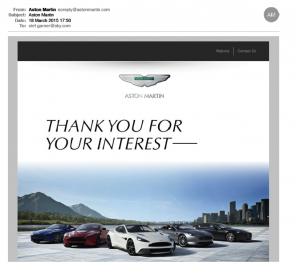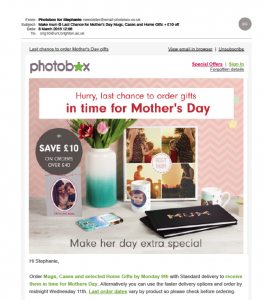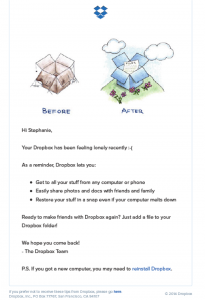Mar
2015
Email Marketing Personalisation: The good the bad and the ugly
Truly personal brand experiences have become a desirable commodity for users, cutting through the cyber babble and striking a chord with target customers, who want to be treated as an individual, by quickly receiving content they want (The Marketer, 2012).
Personalised relationships, are arguably the most important benefit for any sized business using digital media (Taken-Smith, 2011), and have been shown to increase the level of loyalty a customers (Srinivasan, Anderson & Ponnavolu, 2002).
Email is often a common and direct form of targeting customers: especially Generation Y, which can be personalised through: automated triggers, for example using the name of the recipient in the subject line, or opening line to the email content, as well as personalising content to their preferences and previous shopping habits with the host site, tracked by data. The main objectives of personalisation is to build customer relationships and to make communication relevant to the customer so they can relate to the content of the email marketing message (Mohammadi, Malekian, Nosrati, & Karimi, 2013).
This being said, I rarely get e-mails that are personalised with my name or to my interests. I receive an average of 25 emails a day, all of which are mundane junk, that have no relevance to my life or spark my interest. I’m part of Generation Y, who according to Taken-Smith (2011) respond to personalised messages and are an extremely savvy generation, as such, I generally delete these emails without reading or clicking through to the content.
The other day, I signed up to receive Aston Martin’s newsletter (because who doesn’t like to look at nice cars once in a while?!) I was excited to receive my first correspondence from Aston Martin (below), promptly after signing up to their newsletter on their site. But, I found myself disappointed by their sloppy and fairly basic attempt at personalisation, showing that even well-known brands get it wrong.
As part of the newsletter sign-up process, I was required to fill in my name, so I was surprised to see that the email I received, where my name should be, was left blank (indicated by the -). Personalisation is directly linked with how good a company is at gathering accurate data. Aston Martin should have had set up a rule in their data that if the name was blank then personalisation wouldn’t be included, but they haven’t, and it makes them look silly. Therefore, this simple mistake ruined the ‘luxury’ image I had of the brand, and negatively impacted my opinion of their brand equity. Taken-Smith (2011) states that making Generation Y feel ‘like they are special’ is highly influential, especially for relationship building, sadly this was not fulfilled by Aston Martin.
Aston Martin: Bad Example of Personalisation
PhotoBox: Average Example of Personalisation
Generation Y are the most demanding of the generations, who expect brands to work for their business, through vouchers and or discounts in order to show them that you care about their business, by sending them deals directly (Durbin, 2014).
This being said, the e-mail I received from PhotoBox, before Mother’s Day, is a great example of how businesses are personalising offers and discounts in order to adhere to Generation Y’s demanding nature. Although, the message incorporates my name, overall it is a very generic message, and has not necessarily been sent to me because I’m Generation Y, but because I recently purchased some discounted photo prints from their website, and therefore is a basic example of personalisation. However, I probably would have clicked through to the offer, if I hadn’t made my recent purchase.
DropBox: Good Example of Personalisation
A while back I received, what I thought was a really good personalised message from Drop Box… for the following reasons:
- It used my name I had signed up with ‘Stephanie’, as a direct way of capturing my attention that the email was personalised for ‘my eyes only’
- It showcased how to use email personalisation in a mutually beneficial way for DropBox and the user (me), by re-stating the benefits to me, with the hope that this would trigger a behavioural response so that I would once again re-use the service provided (to boost engagement)
- Dropbox’s ability to individually monitor its users
- The email is visually appealing (with minimal text, relevant, yet simple use of images)
- The tone is highly effective by adopting an informal and conversational stance, by personifying my dropbox account, stating that it is ‘feeling lonely’ with an emotion ‘:-(‘… made me want to engage with the content and act upon it
Despite showing how effective personalisation can be, by initiating customer behaviours (through offers, incentives and benefits), only 50% of companies are personalising their website experience and emails for their customers, even-though 94% of companies agree that personalisation ‘is critical to current and future success’ according to Durbin (2014). This is predominately due to business, especially small, not having the dedicated work-force to set-up the personalisation process, and who may also view it as a time consuming process, and may not fully understand how to implement a personalised service for customers.
There is also documented evidence from (Taken-Smith, 2011) showing that personalisation captures 46% of Generation Y’s attention, but is not the most effective strategy.
Lack of data a company or business has on their customers, could prove difficult when trying to personalise to individuals. Besides the fact that ‘personalisation is key’… Personalisation, according to Paul Phillips (Davey, 2014), technical director at Information Builders, is: “an incredibly data intensive task; both combining detailed, historical data and adding future, predictive insight. You need to be combining real-time data from a number of sources (such as GPS location, pages visited, products viewed, etc.) and combining this with an immense amount of background and historic data (such as previous transaction records or demographic detail) that provides additional context. Businesses need to be able to master the balance of live and contextual data to begin to make the most of personalisation.”
As such, a couple of links have been provided below, to offer more insight into personalisation….
How to start personalisation, top-tips
To create a personalised relationship with customers, the following steps by Digital Doughnut (2013) should be taken:
- Greet readers by their first names
- Speak to each reader as if they are your only reader
- Think conversation. Not self-promotion
- Tailor your emails for each recipient
… and to view a step-by-step guide of how to personalise your emails, visit view Hubspots’ blog (2014)
… and, for some inspiration, visit their (Hubspots, 2013) 7 excellent examples of email personalisation in action.
References
Davey, N. (2014) Personalisation is possible – so why are few brands doing it well? MyCustomer [Online] <http://www.mycustomer.com/feature/experience-marketing/personalisation-possible-so-why-are-so-few-brands-doing-it-well/167901> [accessed 1 March 2015]
Digital Doughnut (2013) 4 tips to improve your email marketing with personalisation. [Online] <http://www.digitaldoughnut.com/feeds/feeds/4-tips-to-improve-your-email-marketing-with-personalisation> [accessed 1 March 2015]
Durbin, R. (2014) The importance of data personalisation and localisation. Econsultancy [Online] <https://econsultancy.com/blog/64438-the-importance-of-data-personalisation-and-localisation/> [accessed 27 February 2015]
Hubspot (2014) How to personalise your emails. [Online]<http://knowledge.hubspot.com/email-user-guide/how-to-personalize-your-emails> [accessed 1 March 2015]
Hubspot (2013) 7 excellent examples of email personalisation in action. [Online] <http://blog.hubspot.com/blog/tabid/6307/bid/34146/7-Excellent-Examples-of-Email-Personalization-in-Action.aspx> [accessed 27 February 2015]
Mohammadi, M., Malekian, K., Nosrati, M., & Karimi, R. (2013) Email Marketing as a Popular Type of Small Business Advertisement: A Short Review. Australian Journal of Basic and Applied Sciences. Vol. 7 (Issue 4) p786-790
Srinivasan, S., Anderson, R. & Ponnavolu, K. (2002) ‘Customer loyalty in e-commerce: An exploration of its antecedents and consequences’. Journal of Retailing, [Online] Vol. 78 (Issue 1) < ‘http://connection.ebscohost.com/c/articles/12130375/customer-loyalty-e-commerce-exploration-antecedents-consequences > [accessed 25 February 2015]
Taken-Smith, K. (2011) ‘Digital marketing strategies that Millennials find appealing, motivating, or just annoying’. Journal of Strategic Marketing, [Online] Vol. 19 (Issue 6)<http://www.tandfonline.com/doi/abs/10.1080/0965254X.2011.581383?journalCode=rjsm20#.VRsTaUIbI3Y> [accessed 25 February 2015]
The Marketer (2012) The personal touch: why personalised marketing matters. The Marketer. 22 August 2012. [Online] <http://www.themarketer.co.uk/archives/trends/personalised-marketing/> [accessed 20 February 2015]



